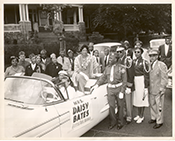|
Review of Passionate Politics: The Life and Times of Charlotte Bunch An Interview with Sharon La Cruise Review of Daisy Bates: First Lady of Little Rock |
||||
 |
||||
Daisy Bates in a parade. Courtesy of Special Collections, University of Arkansas Libraries, Fayetteville. |
||||
Journal Issue 4.2
Viewers are left at once awed by Bates's courageous activism, and at the same time flinching at her seemingly shameless self-promotion. This is an especially promising place for students to analyze the director's intentions. La Cruise has woven together a succession of clips that feature a stunningly beautiful, glamorous Daisy Bates at the center of controversy, danger, and constant attention. Meanwhile, off-camera commentators including the former Little Rock Nine students pose a series of questions that make viewers uncomfortable. While La Cruise's goal here is to force the audience to consider the implications of Bates's obvious pleasure in front of the camera, I can't help but wonder if a male civil rights leader would be subjected to the same kind of scrutiny. While La Cruise glosses over this, it presents another good point of classroom discussion. Does it matter that Bates was movie-star gorgeous and incredibly fashionable? How did her personality, which shines through even on brief clips, affect school desegregation in Little Rock? Did it ultimately contribute to her demise as a civil rights leader?
The story of the Little Rock Nine ends on a positive note, as eight of the nine children make it through a daunting school year. Bates, meanwhile, emerges from the desegregation of Little Rock scarred and battle-weary. She drew the wrath of the white community in Little Rock, which saw to it that her husband's newspaper was shut down. She also aroused the suspicion of the local black community, which remained wary of Bates as an outsider, an opportunist, and a troublemaker. Her marriage in tatters, her livelihood destroyed, and her reputation damaged, Bates moved first to New York City and then later back to Arkansas where she tried her hand at community organizing at the grassroots level. While she helped bring paved roads, better schools, and a community center to a poverty stricken black town in rural Arkansas in the 1970s, she never again experienced the power she enjoyed during the desegregation of Little Rock in 1957. When we see Bates as she is honored at the fiftieth anniversary of Little Rock, she is old, weakened by a series of strokes, and living in desperate poverty. She died soon after sick, impoverished, and mostly forgotten.
While the end of the film is sad, La Cruise resists from portraying this end as tragic. Instead, she wants viewers to consider how a woman could rise to such a prominent leadership position in the movement and then come to this ignoble end. Bates was able to use her drive, glamour, sharp wit and assertiveness to rise to power and make a difference in the history of the black freedom struggle, but it was these same qualities that doomed her long-term career. The story of Daisy Bates as told here will make an interesting contrast to a recent book about Rosa Parks. In The Rebellious Life of Mrs. Rosa Parks, Jeanne Theoharis notes that our national memory of Parks insists that she was "humble," "dignified," "quiet," "soft-spoken," "not angry" and that she "never raised her voice," although Theoharis describes Parks as outspoken, assertive, and rebellious.2 So if Parks was really more "rebellious" than we give her credit for, why was she celebrated as a heroine of the civil rights movement while Bates was discredited? Why is it that Parks is almost always describes in passive, feminine terms--even if historians can find little evidence of the truth of these claims? How did Parks successfully negotiate a leadership position within the movement, while Bates apparently did not? Why are some activists honored and memorialized, while countless others go forgotten? Students could use a comparison of Daisy Bates: First Lady of Little Rock and The Rebellious Life of Mrs. Rosa Parks to try to disentangle how race, gender, and social class worked in the lives of these two women and in the long struggle for black freedom in the United States.
2 Jeanne Theoharis, The Rebellious Life of Mrs. Rosa Parks (New York: Beacon Books, 2013): viii-ix.
Zoë Burkholder (burkholderz@montclair.edu) is an historian of education and an Assistant Professor of Educational Foundations at Montclair State University. She is the author of Color in the Classroom: How American Schools Taught Race, 1900-1954 (Oxford University Press, 2011).
Copyright © 2014. All rights reserved.